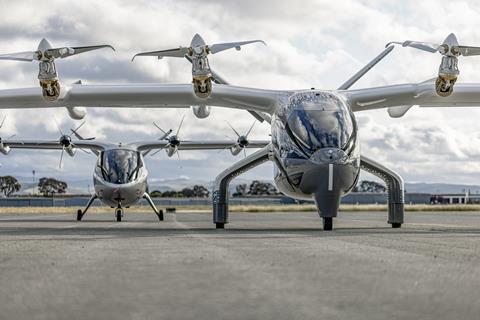Honeywell has no aspirations to design its own advanced air mobility (AAM) vehicle but supplies or is working with many developers of electrically powered aircraft from Archer to Vertical – and holds equity stakes in three.
There is a reason why the US technology company is spreading its bets among a multitude of partners – it does not expect all of them to survive.

“There will be a culling,” says Dan Newman, chief technology officer, advanced air mobility at the newly rebranded Honeywell Aerospace Technologies of the wide field of start-ups and spin-offs developing potential disruptive aviation platforms. “Consolidation is coming, but we are not in a position to decide. Competition is a good thing that yields the strongest industry innovation and products.”
That said, Newman is confident the world is on the verge of a new AAM era as many prototypes near certification and service entry. “There will definitely be air taxi services by 2026, scaling up by the time of the Los Angeles Olympics in 2028,” he says. “Cargo operations with UAS [uncrewed air systems] are already taking place.”
Among the other ventures the Phoenix-based company has supplier arrangements with are Embraer offshoot Eve, Eviation, Heart Aerospace, Pipistrel, and Hyundai’s Supernal.
It has shareholdings in three European developers: Lilium, Vertical Aerospace and Volocopter.
Honeywell formed a dedicated AAM business unit in 2020 and late last year the company claimed that it had secured $10 billion in contract wins from the nascent sector, based on its assessment of the lifetime value of awards and an internal forecast of the number of AAM vehicles it expects to be built.
According to Newman, speaking at a Honeywell media event in London in late March, the technologies offered to the sector span the company’s entire portfolio, including cockpit displays, pilot interfaces, flight control computers, actuators, and thermal management systems. It is partnering with automotive specialist Denso to manufacture electric motors.
Honeywell is also developing AAM-specific tools such as sensors and displays that ensure a pilot can hover directly over a landing spot, and aircraft operate in “tight urban environments”, he says.
“We are not a prime, but we have content on most, if not all, of the leading platforms out there,” Newman continues.
In addition, Honeywell is “collaborating on the regulatory environment with OEM customers” and working with partners on ground infrastructure. “We’re involved in the whole ecosystem,” says Newman.
He acknowledges that the sector faces a number of challenges to create a viable AAM marketplace. These include convincing regulators and the public that battery-powered air taxis and other aircraft are safe, bringing in new external investors, and establishing ground infrastructure such as vertiports and charging stations. Newman believes that, initially at least, existing facilities, such as business aviation fixed-base operations, or FBOs, will be crucial.
He also thinks that some regions will be quicker than others to adopt an AAM market. “There are dramatic cultural differences across the world. There are places such as China and the Middle East that are moving very quickly because governments are not necessarily as collaborative with their public as in Europe and North America.”
Honeywell is carrying out much of the development of its AAM technologies at its research and development centre in Brno, in the Czech Republic, including several European Union-funded projects.





























